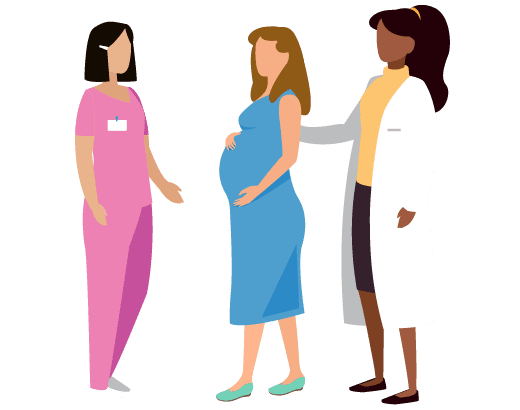Every May, the healthcare industry recognizes the nation’s maternal mortality crisis, specifically related to preeclampsia, HELLP syndrome and related hypertensive disorders of pregnancy. Founded by the Preeclampsia Foundation and its partners, Preeclampsia Awareness Month aims to raise awareness about the condition and its symptoms.
Hypertensive disorders of pregnancy are the second leading cause of maternal death in the U.S., while claiming 40,000+ mothers’ lives globally every year. This major cause of maternal mortality has continued to gain attention with its ongoing incidence rate, considering that within the U.S. alone, the rate of preeclampsia has increased 25%in the last two decades.
The Association of Women’s Health, Obstetric and Neonatal Nurses (AWHONN) has highlighted this alarming issue, noting that every 10 minutes a woman in the United States almost dies of pregnancy-related complications, and recognizing that hypertensive disorders of pregnancy is a leading cause of these complications. It’s estimated that 6-8% of all pregnancies are complicated by hypertensive disorders in the U.S. and 12-22% of pregnancies worldwide.
The Reality of the Unknowns
Although researchers haven’t yet identified the exact cause of preeclampsia, some progress has been made—though some might argue not quickly enough. Per the American College of Obstetricians and Gynecologists (ACOG), there is an undeniable need for additional research related to hypertensive disorders of pregnancy. In 2013, the ACOG Task Force on Hypertension in Pregnancy prepared a report after two years of review, debates, and discussion with 16 expert members. Updated in 2018, the emphasis of the task force continues to focus on:
- Redesigning and improving patient education materials
- Developing better guidelines for preeclampsia “best practices”
- Paying close attention to the evolving research of biomarkers for early screening
Several other national and worldwide quality organizations have also developed resources, toolkits, and guidelines to address hypertensive disorders of pregnancy, such as the California Maternal Quality Care Collaborative’s (CMQCC) Preeclampsia Toolkit.
Improving Postpartum Patient Education
Women with postpartum preeclampsia are often discharged after delivery with little to no patient education on warning signs and symptoms to watch out for—many of which are life threatening. This is an important step in patient education improvement, as postpartum preeclampsia can affect women up to six weeks after delivery.
Recognizing that over half of maternal deaths occur within the first year after childbirth, AWHONN has developed the POST-BIRTH Warning Signs Education Program to help nurses and clinicians implement this life-saving program at their facility. The POST-BIRTH Warning Signs Education Program consists of multiple components:
- An online education course with CNE offering
- Implementation Toolkit
- The Post-Birth Warning Signs Magnet and Magnet templates
- Save Your Life handouts in English, Spanish, Arabic and Mandarin-Chinese translations
This page provides more information and instructions for obtaining the specific materials listed above.
How One Health System is Driving Improvement in Hypertensive Disorders of Pregnancy
Hypertensive disorders of pregnancy improvement efforts are a major focus for many hospitals and health systems across the country, aiming to reduce maternal and perinatal morbidity and mortality. A leading West Coast provider of perinatal services implemented a system-wide strategy aimed at improving maternal safety and driving high-reliability care.
Using a blended model that includes standardization of education and care, transparency and accountability, physician collaboration and simulation, the organization has successfully reduced their rate of eclampsia by 40% across their health system. This webinar shows how they achieved their results.
National Push for Progress
To advance progress on hypertensive disorders of pregnancy, quality organizations are setting new maternal safety standards. Effective July 2020, hospitals that are Joint Commission accredited will be held accountable to demonstrate adherence to new requirements focused on improving the quality and safe care provided to women during all stages of pregnancy and postpartum—particularly in the areas of obstetrical hemorrhage and severe hypertensive/preeclampsia.
To prepare hospitals to meet these new standards, The Joint Commission has issued a new R3 Report that provides guidelines for the 13 new elements of performance (EPs) that fall under the standards. The report provides the requirement, rationale and reference for each EP.
How Relias Can Help
Relias OB (formerly GNOSIS™) is a comprehensive program designed to improve quality and patient safety in five high-acuity obstetrical areas: hypertensive disorders, fetal assessment and monitoring, obstetric hemorrhage, shoulder dystocia, and promoting vaginal birth. Reviewed and approved by AWHONN, this multidisciplinary education solution was developed for advanced obstetric practitioners, including physicians, nurses, and certified nurse-midwives.
Developed by Relias’ obstetrics subject matter experts, this “Saving Mothers with Hypertensive Disorders in Pregnancy” infographic and sample treatment plan provides specific insight on meeting the challenges of delays with education to reduce care variation.

Driving Improvement in Hypertensive Disorders of Pregnancy
One health system successfully reduced their eclampsia rate by more than 40% across the health system through standardization of education and care, transparency and accountability, physician collaboration, and simulation training. Watch this on-demand webinar to learn more about an approach implementing a system-wide strategy aimed at improving maternal safety and driving high-reliability.
Watch the webinar →





